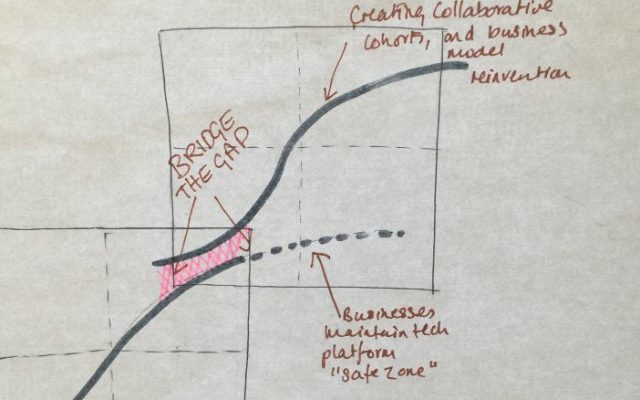Business Change and Delivery programmes have a natural lifecycle. There are three core phases: The first is to establish the strategy and programme following a period of analysis, reviewing the current state and existing business models pros and cons. Next, as the Programme starts to evolve into the delivery and change roll out stages this is where the greatest momentum is seen and experienced. The team and business are running full tilt at delivery and going through the key stages of the transformation.
Finally, the platform or service or product is delivered and rolled out and the sales teams or commercial and business teams are then handling the new business practises and ongoing management of the system. IT and BAU teams are in place and monitoring and measuring, the targets are being tracked and the business is watching and waiting for the much and long-awaited results of the initial business case.
The critical change/switch point?
But this is where most change and business transformations start to slow down and often a slowly complacency starts to set in. The delivery teams have stepped back or moved on to other initiatives and feel people feel that the job is done. You start to see what is traditionally called a ‘long tail’ slow down of activity but all as a result of momentum in building out and on top of the product and/ or service. Some qualify it as the bedding in period, others the expected outcome once the initial release and excitement is over and done.
Other Sales targets, Marketing or UX initiatives are taking the focus elsewhere and so innovation opportunities are lost.
It is just at the point when a change programme delivers that the business and strategic teams should be ramping up to work on how they can take their new platform, tool or suite of products and truly innovate. The hard work has been done to all effect, but it’s at this point that true innovation could and ideally should kick in. Taking the opportunity to innovate, test with customers and really challenge the benefits that you are delivering, and then building upon them, is the cross over point to switching your business in to new collaborative business models and ultimately creating a more disruptive or energetic outcomes.
To innovators, and those who run innovation labs or programmes, workshops, think tanks and hubs, their focus is to bring the core functions together and create collaborative working environments that enable the expansion of ideas and thus turbo charging the opportunities for the business to grow and expand at pace. By recognising the switch point, moving from more traditional growth curves of continuous development and advancement to collaborative models, is the moment that the main curve starts to slow and level of or will create a new work stream and levels of energy. By bringing in innovation teams or running labs and workshops or hubs, in parallel (which is key in the switch from one to the other) you are truly able to test and learn from ideas that may otherwise just hang in the minds of your internal staff, or external innovators that could truly take your business to new levels. The new collaborative methodologies will in time dissolve the traditional BAU and continuous improvement work stream, but there is a period where the 2 run in parallel and hand- offs between the two are critical.
The core premise of new collaboration business model?
It pulls together the new platform, challenges further and tests the current business model, reviews data and insight looking at more integral ways to utilise the wealth of information being gathered from your clients and distributors, partners and colleagues. This then combines these elements to derive new tools, apps and tangible functionality to your end customers that truly transforms their experience with you beyond the solid and stable platform that you have invested time and money in implementing to that point. Why for example would you invest in a new platform or a business transformation approach, and then not continue to build on the investment by making it work harder for you and bringing more benefits to both your business and customer/ partners/ suppliers?
When I consult with businesses on this innovation approach and the disruptive and new business models that are evolving out of the traditional digital and business change programmes I ask some core questions:
- Talk me through your current organisation
- Describe to me the future that’s coming and how you envision this evolving on the structure and technologies you have in place
- What are the companies’ core initiatives and objectives and how well do you think you are delivering against these?
- What is the market doing that might be impacting your business and how is it different to your offering? (and what are the threats?)
- Is the model that you have in place serving you well and is it the right business model for your future business vision and goals?
- Is your remit one of maintaining efficiency, or to grow profit and product offerings, build customer interactions?
- How collaborative is your business or do you see silos?
By asking these questions I’m asking the business leaders to see how their structure and organisation is working together and where there are opportunities to build on the change that they are already creating. Businesses often fear innovation as they think that it can lead to expensive mistakes further down the line. In fact it’s quite the opposite. By interrogating what is there and whether it’s working well or not, you are able to identify and gain feedback from both your colleagues and teams as well as key insights from your customers, upfront and early in the cycle and thus preventing significant investment in tools, apps or technology that may not be adopted or engaged, or even worse, becomes rapidly redundant!
So how do you drive innovation?
It’s ultimately a simple process – brainstorm and gather ideas for innovation. Spend 1-3 days (or more in-depth targeting industry or service labs for a couple of weeks) running a developers innovation lab to build prototypes and then test with your clients/ customers to see what works and what sticks and what doesn’t.
This can all be done at low cost and gives early feedback on where potential new engagement streams, sales and revenue generation tools could be developed and rolled out, and also removal of current or redundant functionality that is not fully serving the purpose intended, or failing to meet objectives. It is likely that by identifying these new innovative prototypes there is the potential to shoot the business into new market place or a higher state of momentum and drive. I’ve seen this with a number of commerce clients and across my network where businesses that are fully engaging with innovation streams and business model reinvention techniques that they are within 3-6 weeks, and certainly less than a handful of months, able to identify a shortlist of ideas, build them out in a hub or lab and once consumer or customer tests have been carried out, able in a matter of weeks to develop, implement and roll out whole new applications and features or toolsets. This results in a huge uplift in customer engagement, marketing campaigns, sales and revenue opportunities and results, and has (re)defined the brand or business as a leader in innovation and techniques.
This is not all without effort and bravery. The leaders who look at business model reinvention, innovation and fast paced delivery cycles are demanding 3 factors from their teams:
– The first is to tear up the governance and traditional delivery rulebooks and look at risk from an alternate perspective – that of “test and learn and fail fast”.
– The second is to empower and hand responsibility to the teams driving the labs and hubs to create remarkable and often ‘maverick’ ideas that would in a traditional delivery programme never see the light of day, being dismissed as too blue sky or out of the ball park.
– The third is to apportion a percentage of the budget to enable the labs, prototyping, UX and customer research, user-testing activities that provide the clear insights upfront, as to whether further investment is viable or not. Once defined as a valid opportunity there is still time to build business cases and allocate budget, and build out via the traditional delivery and implementation teams, but the key differentiator is that you have already de-risked the product or service delivery success as you know its something that the marketplace want.
Innovation is possible when the cornerstones of technology, data insights, platform, services and strategy are all in place already and are all collaborating together. Some innovate (we all know the Ubers of the world) from scratch but they have still gone through the innovation approach to identify the opportunity or gap in the market before building out the platform to deliver it.
Article by channel:
Everything you need to know about Digital Transformation
The best articles, news and events direct to your inbox
Read more articles tagged: Change & Transformation






